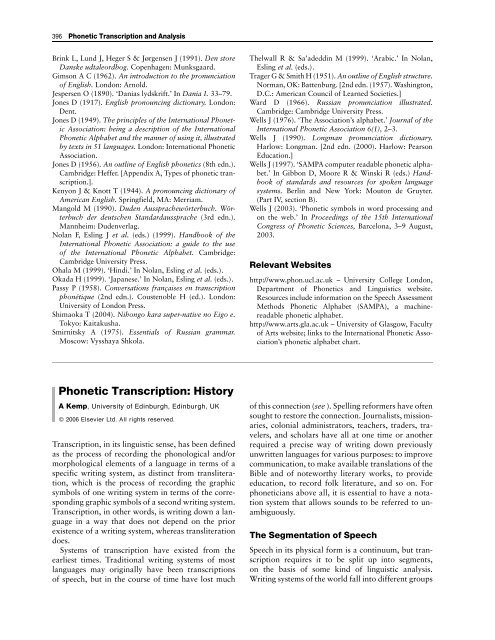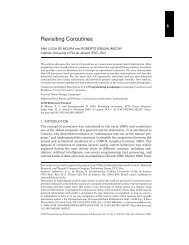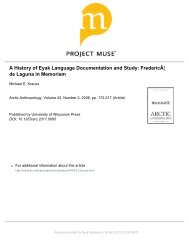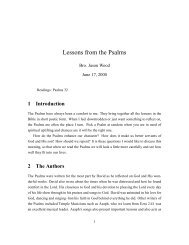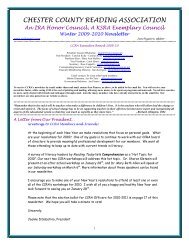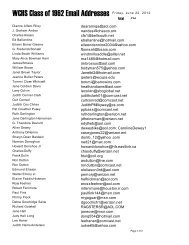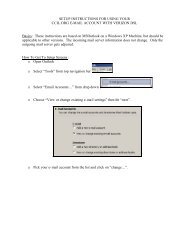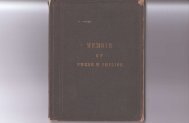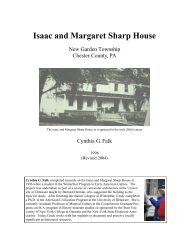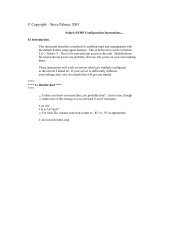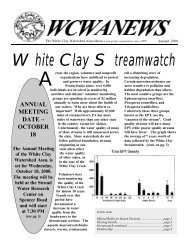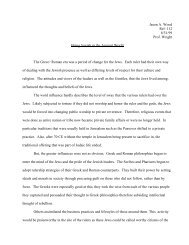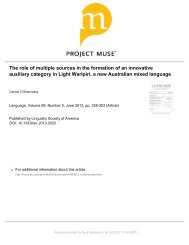You also want an ePaper? Increase the reach of your titles
YUMPU automatically turns print PDFs into web optimized ePapers that Google loves.
396 <strong>Phonetic</strong> <strong>Transcription</strong> and Analysis<br />
Brink L, Lund J, Heger S & Jørgensen J (1991). Den store<br />
Danske udtaleordbog. Copenhagen: Munksgaard.<br />
Gimson A C (1962). An introduction to the pronunciation<br />
of English. London: Arnold.<br />
Jespersen O (1890). ‘Danias lydskrift.’ In Dania I. 33–79.<br />
Jones D (1917). English pronouncing dictionary. London:<br />
Dent.<br />
Jones D (1949). The principles of the International <strong>Phonetic</strong><br />
Association: being a description of the International<br />
<strong>Phonetic</strong> Alphabet and the manner of using it, illustrated<br />
by texts in 51 languages. London: International <strong>Phonetic</strong><br />
Association.<br />
Jones D (1956). An outline of English phonetics (8th edn.).<br />
Cambridge: Heffer. [Appendix A, Types of phonetic transcription.].<br />
Kenyon J & Knott T (1944). A pronouncing dictionary of<br />
American English. Springfield, MA: Merriam.<br />
Mangold M (1990). Duden Aussprachewörterbuch. Wörterbuch<br />
der deutschen Standardaussprache (3rd edn.).<br />
Mannheim: Dudenverlag.<br />
Nolan F, Esling J et al. (eds.) (1999). Handbook of the<br />
International <strong>Phonetic</strong> Association: a guide to the use<br />
of the International <strong>Phonetic</strong> Alphabet. Cambridge:<br />
Cambridge University Press.<br />
Ohala M (1999). ‘Hindi.’ In Nolan, Esling et al. (eds.).<br />
Okada H (1999). ‘Japanese.’ In Nolan, Esling et al. (eds.).<br />
Passy P (1958). Conversations françaises en transcription<br />
phonétique (2nd edn.). Coustenoble H (ed.). London:<br />
University of London Press.<br />
Shimaoka T (2004). Nihongo kara super-native no Eigo e.<br />
Tokyo: Kaitakusha.<br />
Smirnitsky A (1975). Essentials of Russian grammar.<br />
Moscow: Vysshaya Shkola.<br />
<strong>Phonetic</strong> <strong>Transcription</strong>: <strong>History</strong><br />
A Kemp, University of Edinburgh, Edinburgh, UK<br />
� 2006 Elsevier Ltd. All rights reserved.<br />
<strong>Transcription</strong>, in its linguistic sense, has been defined<br />
as the process of recording the phonological and/or<br />
morphological elements of a language in terms of a<br />
specific writing system, as distinct from transliteration,<br />
which is the process of recording the graphic<br />
symbols of one writing system in terms of the corresponding<br />
graphic symbols of a second writing system.<br />
<strong>Transcription</strong>, in other words, is writing down a language<br />
in a way that does not depend on the prior<br />
existence of a writing system, whereas transliteration<br />
does.<br />
Systems of transcription have existed from the<br />
earliest times. Traditional writing systems of most<br />
languages may originally have been transcriptions<br />
of speech, but in the course of time have lost much<br />
Thelwall R & Sa’adeddin M (1999). ‘Arabic.’ In Nolan,<br />
Esling et al. (eds.).<br />
Trager G & Smith H (1951). An outline of English structure.<br />
Norman, OK: Battenburg. [2nd edn. (1957). Washington,<br />
D.C.: American Council of Learned Societies.]<br />
Ward D (1966). Russian pronunciation illustrated.<br />
Cambridge: Cambridge University Press.<br />
Wells J (1976). ‘The Association’s alphabet.’ Journal of the<br />
International <strong>Phonetic</strong> Association 6(1), 2–3.<br />
Wells J (1990). Longman pronunciation dictionary.<br />
Harlow: Longman. [2nd edn. (2000). Harlow: Pearson<br />
Education.]<br />
Wells J (1997). ‘SAMPA computer readable phonetic alphabet.’<br />
In Gibbon D, Moore R & Winski R (eds.) Handbook<br />
of standards and resources for spoken language<br />
systems. Berlin and New York: Mouton de Gruyter.<br />
(Part IV, section B).<br />
Wells J (2003). ‘<strong>Phonetic</strong> symbols in word processing and<br />
on the web.’ In Proceedings of the 15th International<br />
Congress of <strong>Phonetic</strong> Sciences, Barcelona, 3–9 August,<br />
2003.<br />
Relevant Websites<br />
http://www.phon.ucl.ac.uk – University College London,<br />
Department of <strong>Phonetic</strong>s and Linguistics website.<br />
Resources include information on the Speech Assessment<br />
Methods <strong>Phonetic</strong> Alphabet (SAMPA), a machinereadable<br />
phonetic alphabet.<br />
http://www.arts.gla.ac.uk – University of Glasgow, Faculty<br />
of Arts website; links to the International <strong>Phonetic</strong> Association’s<br />
phonetic alphabet chart.<br />
of this connection (see ). Spelling reformers have often<br />
sought to restore the connection. Journalists, missionaries,<br />
colonial administrators, teachers, traders, travelers,<br />
and scholars have all at one time or another<br />
required a precise way of writing down previously<br />
unwritten languages for various purposes: to improve<br />
communication, to make available translations of the<br />
Bible and of noteworthy literary works, to provide<br />
education, to record folk literature, and so on. For<br />
phoneticians above all, it is essential to have a notation<br />
system that allows sounds to be referred to unambiguously.<br />
The Segmentation of Speech<br />
Speech in its physical form is a continuum, but transcription<br />
requires it to be split up into segments,<br />
on the basis of some kind of linguistic analysis.<br />
Writing systems of the world fall into different groups
according to what types of segments they are based<br />
on – words, syllables, or consonants and vowels.<br />
Certain features of speech are associated with longer<br />
segments than others; for example, stress and intonation,<br />
which in many writing systems are not marked,<br />
are associated with stretches of speech such as the<br />
syllable, word, or sentence.<br />
Types of <strong>Transcription</strong><br />
A transcription can never capture all the nuances<br />
of speech. The amount of detail it attempts to<br />
include in its text will vary according to its purpose.<br />
A system intended for the specialist linguist investigating<br />
a language never previously studied would<br />
often need to allow the recording of as many as<br />
possible of the various nuances of sounds, pitch variations,<br />
voice quality changes, and so on. Such a<br />
transcription may be called ‘impressionistic,’ and<br />
is unlikely to be helpful to anyone other than a<br />
specialist.<br />
Proceeding from this initial transcription, the linguist<br />
can deduce the way in which the sound system<br />
of the language is structured, and can replace the<br />
impressionistic transcription with a ‘systematic’ one,<br />
which records in its text only the elements that are<br />
crucial for conveying the meanings of the language.<br />
This type of transcription may well form the basis<br />
for a regular writing system for that language, and is<br />
called a ‘phonemic,’ or ‘broad,’ transcription. For use<br />
in teaching the spoken language, however, it may be<br />
helpful to transcribe some of the subphonemic sound<br />
differences likely to present problems to the learner.<br />
This kind of transcription may be called ‘allophonic,’<br />
or ‘narrow.’ If detailed comparisons are to be made<br />
between this language or dialect and another one,<br />
showing the more subtle sound distinctions, the transcription<br />
may begin to resemble the impressionistic<br />
one, but as it is the result of a prior analysis, it will<br />
still be systematic. Conventions may be supplied to<br />
show the way in which the broad transcription is<br />
realized phonetically in certain environments. For<br />
special purposes, such as recording the speech of<br />
the deaf, very complex transcription systems may be<br />
necessary, to cope with sound variations that rarely<br />
occur in the speech of those without such a disability<br />
(see later, discussion of the International <strong>Phonetic</strong><br />
Association).<br />
Notation<br />
<strong>Transcription</strong> systems need to employ a notation that<br />
allows them to refer to a sound unambiguously. The<br />
following approaches utilize some of the principles<br />
followed in effective systems of notation:<br />
<strong>Phonetic</strong> <strong>Transcription</strong>: <strong>History</strong> 397<br />
1. To avoid ambiguity, each symbol used in the notation,<br />
in its particular environment, should be restricted<br />
to one particular sound or sound class<br />
(or, in some cases, groups of sounds, such as the<br />
syllable), and each sound, etc. should be represented<br />
by only one symbol. So, for instance, the<br />
symbol , which has different values in German<br />
and English orthography, would need to be confined<br />
to only one of those values. Conversely,<br />
the sound [s], which in English may be conveyed<br />
either by as in ‘supersede’ or as in ‘cede,’<br />
must be limited to only one symbol.<br />
2. The symbols used should ideally be simple, but<br />
distinctive in shape, easily legible, easy to write<br />
or print, aesthetically pleasing, and familiar to<br />
the intended users. If printing types are not<br />
readily available, the system will be limited in its<br />
accessibility and expensive to reproduce.<br />
3. If the transcription is to be pronounceable (not all<br />
kinds are required to be), the sound values of the<br />
symbols must be made clear, through a description<br />
of the ways in which the sounds are formed,<br />
or through recorded examples, or by ‘key words’<br />
taken from a language, provided that the accent<br />
referred to is specified. Some transcription systems<br />
include pieces of continuous text to illustrate the<br />
application to particular languages (e.g., those<br />
of Carl Lepsius and the International <strong>Phonetic</strong><br />
Association (IPA); see later).<br />
4. The symbol system should be expandable,<br />
particularly if it is intended to be used to cover<br />
all languages. As new languages are encountered,<br />
new varieties of sounds will have to be defined.<br />
Alphabetic Notations: Roman and Non-Roman<br />
Alphabetic notations (e.g., the Roman alphabet) are<br />
based on the principle of having one simple symbol<br />
to represent each segment. However, many transcription<br />
systems are not based on the Roman alphabet,<br />
because of the ambiguous values of some of its symbols,<br />
or because it has been found preferable to use<br />
‘iconic’ symbols, intended to convey by their shapes<br />
the phonetic nature of the sound concerned, and/or<br />
to link related groups of sounds. One variety of iconic<br />
notation has been called ‘organic,’ because the shapes<br />
of its symbols are meant to suggest the organs of<br />
speech used to produce them. Shorthand systems<br />
characteristically are non-Roman and iconic, but<br />
not necessarily organic. Iconic systems have a number<br />
of drawbacks. Apart from the difficulties of reading<br />
and printing them, they cannot be easily expanded<br />
to incorporate sounds newly encountered. It is also<br />
less easy to adapt them as and when phonetic theory<br />
undergoes changes.
398 <strong>Phonetic</strong> <strong>Transcription</strong>: <strong>History</strong><br />
Analphabetic Systems<br />
Analphabetic systems are not based on alphabetictype<br />
segments; instead, the symbols are composed<br />
of several elements, some of which resemble chemical<br />
formulas, each element representing one ingredient<br />
of the sound concerned (see later).<br />
Supplementing the Roman Alphabet<br />
The number of Roman symbols is far too limited<br />
to convey the sound distinctions needed. There are<br />
various ways of supplementing the basic alphabet (see<br />
Abercrombie, 1981):<br />
1. Using ‘compound letters’ such as and<br />
(equivalent to [k(w)] and [ks], respectively,<br />
in English orthography) to stand for other sounds.<br />
Thus may be used to represent the Scottish<br />
sound represented by the in ‘loch.’<br />
2. Inverting and/or reversing the letters and giving<br />
them other values, e.g., [O e J M r V] are all phonetic<br />
symbols formed by inverting , respectively.<br />
3. Adding diacritical marks to basic symbols, as in<br />
. These diacritics may be attached to the<br />
letter or placed somewhere adjacent to it. They are<br />
an economical way of enlarging the repertoire,<br />
because one mark can be used to change the<br />
value of a number of symbols; for example, [�]<br />
represents nasality and may be added above any<br />
vowel symbol. Conversely, being small, diacritics<br />
may be inadvertently omitted or obscured, they<br />
tend to reduce the legibility of texts, and they can<br />
be expensive to reproduce (though less so since the<br />
advent of computers).<br />
4. Adapting symbols borrowed from other alphabets;<br />
examples of symbols taken from Greek by the<br />
International <strong>Phonetic</strong> Alphabet, with modification<br />
to blend with the roman font, are [y w b X]<br />
(see International <strong>Phonetic</strong> Association). Symbols<br />
may also be borrowed from another use, such as<br />
@), £, $, %, etc.<br />
5. Using digraphs to represent simple sounds, as<br />
English orthography does in ‘thing,’ wherein <br />
and may represent the simple sounds [y],<br />
and [N], respectively. The symbols are easily accessible,<br />
but problems arise when these sequences are<br />
needed to convey actual sound sequences, such as<br />
the aspirated stop [th].<br />
6. Using different typefaces, such as UPPERCASE,<br />
italic, or bold (or even ). However,<br />
these are less satisfactory for use in handwriting,<br />
they may cause confusion with other conventional<br />
uses, such as emphasis, and they do not blend well<br />
with other fonts, unless specially adapted.<br />
7. Less commonly, using spatial relationships. With<br />
respect to a median line, symbols may be placed on<br />
the line, above it, or below it. Braille makes use of<br />
this in certain of its symbols. For normal printing<br />
and writing this is not very satisfactory, as it interferes<br />
with legibility and can easily lead to errors.<br />
8. Inventing entirely new symbols. Unless new symbols<br />
are relatively straightforward adaptations of<br />
Roman letters, e.g., inversions or addition of diacritics,<br />
they rarely survive. One that has survived is<br />
the IPA symbol for the velar nasal, [N], probably<br />
first used in 1619 by Alexander Gill.<br />
Nonsegmental Aspects of Speech<br />
In any language, English, for example, the position of<br />
the stress in the word may need to be indicated. This<br />
can be done by placing a raised mark before the<br />
stressed syllable, for instance, ,<br />
or by highlighting the syllable in some way. Extra<br />
length can be shown by doubling the segmental symbol,<br />
as in Italian freddo ‘cold’, or by adding a diacritical<br />
mark, as in [a:]. Pitch is an essential feature of the<br />
words of ‘tone languages,’ such as Chinese, Thai, and<br />
Yoruba, and may be marked by accents over the<br />
vowel (e.g., [á] ¼ high, [à] ¼ low), or by numerals<br />
(e.g., the Mandarin Chinese segmental structure<br />
[ma] can have four different tones, distinguishing<br />
different words: [ma 1 ], [ma 2 ], [ma 3 ], [ma 4 ]). The intonation<br />
pattern of English may be indicated by<br />
marking the pitch of certain prominent syllables.<br />
The first person to try to provide a detailed system<br />
of notation for these features in English was Joshua<br />
Steele (see Steele, Joshua (1700–1791)). Other features<br />
are also sometimes treated as nonsegmental,<br />
notably nasality and ‘secondary articulations’ such<br />
as palatalization, velarization, and labialization, because<br />
they frequently overlap segmental boundaries.<br />
Traditional transcriptions have allocated these features<br />
to segments, adding diacritical marks to the<br />
vowel or consonant symbols, but some phonological<br />
analyses of speech have associated them with longer<br />
stretches by setting up an extra tier for them. The<br />
‘prosodic analysis’ of J. R. Firth allocated ‘prosodies’<br />
such as nasality and velarity to longer domains,<br />
including syllable part, syllable, word, and sentence<br />
(see Firthian Phonology). A similar idea lies behind<br />
the ‘autosegmental’ model of phonology.<br />
Historical Survey of<br />
<strong>Transcription</strong> Systems<br />
Examples of some of the different types of transcription<br />
systems can be found in the alphabets from<br />
early times.
Roman-Based Alphabetic Systems<br />
(pre-19th Century)<br />
The reform of traditional orthographies (notably<br />
those of French and English, which presented particular<br />
problems for learners) led to innovations<br />
in notation. In France, Loys Meigret’s La Tretté de<br />
la grammere françoeze (1550; see Meigret, Louis<br />
(?1500-1558)) included a phonetically based alphabet<br />
for French. In England, Sir Thomas Smith, in his<br />
De recta et emendata linguae anglicanae scriptura<br />
(On the proper and corrected writing of the English<br />
language) (Paris, 1568), employed several of the<br />
devices mentioned previously. For example, diacritics<br />
([ H]) were used to distinguish the long vowels in<br />
‘cheap’ and ‘hate,’ symbolized and , respectively;<br />
non-Roman alphabets (Greek ) were used<br />
for French and Scottish u (i.e., [y]); and the Irish form<br />
of capital was used to represent the first consonant<br />
in ‘judge.’ A reversed replaced the of<br />
‘ship,’ and for the dental fricatives, Smith used Old<br />
English ‘thorn’ and (see Figure 1).<br />
John Hart (see Hart, John (?1501-1574)) was familiar<br />
with Meigret’s system. His book, An orthographie<br />
(London, 1569), included special symbols for the<br />
consonant sounds [y ð S tS dZ], beautifully integrated<br />
into the text. He was a keen observer of speech and<br />
recorded the occurrence of syllabic consonants such<br />
as the final in ‘fable,’ which he transcribed as<br />
. Subsequently, William Bullokar (see Bullokar,<br />
William (c. 1531–1609)), in his Book at large for the<br />
amendment of orthographie for English speech (London,<br />
1580), provided 40 symbols for transcribing<br />
English. By using a font he opened up<br />
extra possibilities of rarely used printing sorts. He<br />
illustrated his phonetic alphabet by using it in a number<br />
of literary texts, including Aesop’s fables.<br />
In Logonomia Anglica (first edition published<br />
in London in 1619), Alexander Gill (1564–1635)<br />
introduced a number of extra letters. Like Smith, he<br />
used for the first sound in ‘this,’ and in the<br />
second edition (1621) of his work he introduced<br />
for the velar nasal, thus maintaining the connection<br />
with nasal . He transcribed the word ‘high’<br />
as , using for the vowel and for the<br />
final consonant. This illustrates the use of a diacritic<br />
incorporated in a letter. Charles Butler, in his English<br />
Figure 1 Symbols devised in 1568 by Sir Thomas Smith, to<br />
represent the final sound made when pronouncing the words<br />
pith, bathe, and dish.<br />
<strong>Phonetic</strong> <strong>Transcription</strong>: <strong>History</strong> 399<br />
grammar (Oxford, 1633), also used a horizontal<br />
stroke through certain letters to avoid digraphs,<br />
replacing the letter , so that instead of he had , respectively, with<br />
a stroke through each letter. He also introduced<br />
inverted to represent the in ‘thin.’<br />
John Wilkins (see Wilkins, John (1614–1672)), in<br />
his Essay towards a real character (1668), devised<br />
three separate systems of notation (see Figure 2).<br />
One of these is Roman based and uses digraphs to<br />
supply extra consonant symbols. The letter has<br />
a dual role: it is used both to indicate fricatives, as in<br />
(for [x X y ð S Z]), and to<br />
indicate voiceless forms of nasals and liquids, so that<br />
voiced are paralleled by [voiceless<br />
. For some of the vowels,<br />
Wilkins employed rather poorly designed Greek symbols,<br />
though this contradicted one of his stated principles<br />
for choosing symbols:<br />
1. They should be the most simple and facil, and yet<br />
elegant and comely as to the shape of them.<br />
2. They must be sufficiently distinguished from one<br />
another.<br />
3. There should be some kind of suitableness, or correspondency<br />
of the figure to the nature and kind of the<br />
letters which they express.<br />
Wilkins’s third condition refers to a nonarbitrary, or<br />
iconic, type of notation (for his other notations, see<br />
later, Iconic Alphabets, pre-19th Century).<br />
Figure 2 Three non-Roman transcriptions. (A) Iconic representations<br />
of the sounds [l] and [m] (John Wilkins, 1668). (B) Syllabic<br />
transcription of ‘Give us this day our daily bread’ (John Wilkins,<br />
1868). (C) Organic alphabet. <strong>Transcription</strong> of ‘I remember. I<br />
remember, the roses red and white’ (Henry Sweet, 1906).
400 <strong>Phonetic</strong> <strong>Transcription</strong>: <strong>History</strong><br />
Figure 3 Excerpt illustrating the extended alphabet devised by Benjamin Franklin in 1768 (published in Franklin’s collected works<br />
in 1779).<br />
In the 18th century, social reformers aiming to reduce<br />
class barriers tried to establish a standard form of<br />
pronunciation; to facilitate the spread of literacy,<br />
reformed spelling systems were suggested. Thomas<br />
Sheridan (see Sheridan, Thomas (1719–1788)) was<br />
one of the first to publish a pronouncing dictionary<br />
of English (1780), which gave a respelling to every<br />
word, and a similar dictionary was published in<br />
1791 by John Walker (see Walker, John (1732–<br />
1807)). In America, spelling reform led the famous<br />
American statesman, scientist, and philosopher, Benjamin<br />
Franklin, to put forward a new alphabet in<br />
1768. It was limited to 26 symbols, of which six<br />
were newly invented to take the place of the ‘ambiguous’<br />
letters . Some of these new symbols<br />
were rather too similar to each other in form to be<br />
satisfactory, but the printed font was attractively<br />
designed; it was published as part of Franklin’s collected<br />
works (London, 1779) (see Figure 3).<br />
William Thornton (1759–1828), a Scottish<br />
American who traveled and lived in many places but<br />
who spent most of his life in the American capital,<br />
Washington, also attempted to reform English<br />
spelling, and in the longer term to make possible the<br />
transcription of unwritten languages. His treatise,<br />
entitled Cadmus, or a treatise on the elements of<br />
written language (1793), won the Magellanic gold<br />
medal of the American Philosophical Society. The<br />
notation he used was Roman based and introduced<br />
some well-designed additional letters, including <br />
to replace , to represent the first consonant<br />
in ‘ship,’ and a circle with a dot in the center (8,<br />
a Gothic symbol) to represent in ‘when.’ He<br />
aimed to economize by using inverted basic symbols<br />
where possible, e.g., , , . Some<br />
years later, Thornton used his alphabet to transcribe<br />
288 words in the Miami Indian language. Among<br />
admirers of his system were Thomas Jefferson,<br />
Alexander von Humboldt, and Count Volney (see<br />
later, Volney and the Volney Prize).<br />
The increasing involvement of Europeans with the<br />
languages of Asia, Africa, and America, whether as<br />
traders, missionaries, travelers, or colonial administrators,<br />
emphasized the need for a standard, universal<br />
alphabet. One of the first to try to provide a transliteration<br />
for Asian languages was the brilliant English<br />
oriental scholar and linguist Sir William Jones<br />
(see Jones, William, Sir (1746–1794)). He was a highly<br />
skilled phonetician, and during his time as a high<br />
court judge in India (1783–1794) saw the need for a<br />
consistent way of transcribing languages. His system<br />
was presented in Dissertation on the orthography of<br />
Asiatick words in Roman letters (1788). He thought<br />
it unnecessary to provide any detailed account of the<br />
speech organs, but gave a short description of the<br />
articulations. An ideal solution, he believed, would<br />
be to have ‘‘a natural character for all articulate<br />
sounds . . . by delineating the several organs of speech<br />
in the act of articulation’’ (i.e., an ‘organic’ alphabet),<br />
but for oriental languages he preferred a transliteration.<br />
This was partly because of the difficulty of<br />
conveying the precise nature of sounds to the nonspecialist,<br />
but also because he wished to preserve the<br />
orthographical structure, so that the ‘grammatical<br />
analogy’ would not be lost, and there would be no<br />
danger of representing ‘‘a provincial and inelegant<br />
pronunciation.’’ The system was not intended as a<br />
universal alphabet; his notation was confined to the<br />
letters of the Roman alphabet, supplemented by<br />
digraphs and a few diacritics. He chose the vowel<br />
symbols on the basis of the values they have in the<br />
Italian language, rather than those of English, unlike<br />
some other schemes used in India at the time. His<br />
alphabet had an influence on nearly all subsequent<br />
ideas for the transliteration of oriental languages, at<br />
least for the following century. The romanization of<br />
these languages became a major concern of missionaries,<br />
administrators, educationists, and travelers,<br />
though some scholars, and literate members of the<br />
communities concerned, were less enthusiastic, believing<br />
that something culturally vital would be lost<br />
if the native scripts were changed into a different form.<br />
Iconic Alphabets (pre-19th Century)<br />
Two of John Wilkins’s systems of notation were iconic.<br />
The more elaborate one, which was not intended<br />
to be used to transcribe connected speech, consisted<br />
of small diagrams of the head and neck, cut away to<br />
show the articulatory formation of each sound. Next<br />
to each diagram was a simplified symbol relating to<br />
the way the sound was formed (see Figure 2A). The<br />
second notation assigned each consonant a symbol,<br />
which took various forms: straight line, T shape,<br />
L shape, or various curve shapes. To this basic shape
Wilkins added a small circle or hook, at the top,<br />
middle, or base, to represent one of six vowels. Thus<br />
the composite symbol represented a syllable, either<br />
vowel þ consonant or consonant þ vowel. Each category<br />
of sound, such as oral stop consonant, fricative,<br />
or nasal, had a characteristic shape, as did voiceless<br />
and voiced sounds at the same place of articulation.<br />
The system was ingenious, but the symbols could<br />
easily be confused, and it is unlikely that anyone<br />
other than Wilkins actually used it (see Figure 2B).<br />
Wilkins’s contemporary, Francis Lodwick (see<br />
Lodwick, Francis (1619–1694)), published a similar<br />
system in 1686 under the title An essay towards an<br />
universal alphabet. He stated in his text the important<br />
principle that ‘‘no one character should have more<br />
than one sound, nor any one sound be expressed by<br />
more than one character.’’ The notation was a syllabary,<br />
using shapes designed to show similarities between<br />
the sounds symbolized, which are set out in a<br />
table with six places of articulation: bilabial, dental,<br />
palatal, velar, labiodental, and alveolar. The top symbol<br />
in each column is the voiced stop, and the lower<br />
ones are formed by progressive modifications of it. As<br />
with Wilkins’s system, the vowels are added to the<br />
consonant symbols as diacritics.<br />
Another iconic alphabet is to be found in chapter 5<br />
of the Traité de la formation méchanique des langues,<br />
published in 1765 by the French scholar and magistrate,<br />
Charles de Brosses (see Brosses, Charles de<br />
(1709–1777)). The work was intended for scholars<br />
researching into languages, rather than for everyday<br />
use. Brosses called it ‘organic and universal.’ It is<br />
based on a somewhat idiosyncratic analysis of speech<br />
production, which, among other things, assumed that<br />
the vowels were sounded at different points on a<br />
corde, or string, equivalent to the vocal tract tube.<br />
Brosses’s understanding of speech production is suspect<br />
in a number of ways; for example, he classes<br />
as a nasal consonant. His first attempt at notation<br />
was complex, using symbols that pictured the<br />
outline of the different vocal organs (lips, teeth, palate,<br />
nose, etc.), but he simplified this subsequently,<br />
using symbols made up of curves and straight lines<br />
at different angles. The vowel symbols were attached<br />
to the consonants to give a syllabic sign, and the<br />
notation included composite symbols to represent<br />
consonant clusters.<br />
Nineteenth-Century <strong>Transcription</strong><br />
Systems<br />
Volney and the Volney Prize<br />
The French orientalist, statesman, and reformer,<br />
Count Constantin François Volney (see Volney,<br />
<strong>Phonetic</strong> <strong>Transcription</strong>: <strong>History</strong> 401<br />
Constantin-Francois Chasseboeuf, Comte de<br />
(1757–1820)), had been concerned for many years<br />
about the difficulties experienced by Europeans in<br />
learning oriental languages, and the poor standard<br />
of the teaching of these languages. His book, Simplification<br />
des langues orientales (Paris, 1795), put forward<br />
a system for transliterating Arabic, Persian, and<br />
Turkish into Roman script, supplemented by a few<br />
Greek letters and some newly invented symbols. During<br />
a visit to America from 1795 to 1798, he stayed<br />
with William Thornton, and while there became<br />
acquainted with Sir William Jones’s alphabet. He<br />
conceived the idea of a universal alphabet, not for<br />
scholarly purposes, but to act as a practical tool for<br />
travelers, traders, etc. His 1795 system was used with<br />
modifications for geographical names on the map of<br />
Egypt compiled in 1803 by the French government,<br />
but his later L’Alphabet européen appliqué aux langues<br />
asiatiques (Paris, 1819) provided a fuller system<br />
of 60 symbols, mostly Roman, replacing some of his<br />
previous, newly invented, symbols with more familiar<br />
letters modified by diacritics. However, Volney realized<br />
that further research was needed, and his final<br />
gesture was to leave 24 000 francs in his will, for a<br />
prize to be awarded by the Institut de France to<br />
anyone who could devise a suitable ‘harmonic alphabet’<br />
(to bring harmony out the existing confusion of<br />
practices) in Roman script (see Kemp, 1999).<br />
The Volney Prize for the first year (1822) was to be<br />
for an essay setting out the necessary conditions for<br />
such an alphabet. The prizewinners were both German<br />
librarians: Josef Scherer (d. 1829) argued that<br />
what was needed was a transcription reflecting pronunciation,<br />
rather than a transliteration, whereas<br />
A. A. E. Schleiermacher (1787–1858), the co-winner,<br />
favored a transliteration, for very much the same<br />
reasons as those given by Sir William Jones. Scherer<br />
and Schleiermacher submitted detailed transcription<br />
systems for the 1823 prize, which was won by<br />
Scherer; Schleiermacher’s essay was submitted later<br />
in a revised form and was published in 1835. He<br />
continued to work on his system, and his completed<br />
scheme, Das harmonische oder allgemeine Alphabet<br />
zur <strong>Transcription</strong> fremder Schriftsysteme in lateinische<br />
Schrift (The harmonic or general alphabet for<br />
the transcription of foreign writing systems into Latin<br />
script), was eventually published in Darmstadt, after<br />
his death (1864). Together with his new alphabet, this<br />
work contained examples of the non-Roman scripts<br />
of 10 languages. In all, 275 new characters had to be<br />
cast. His notation excluded digraphs and letters from<br />
other alphabets, which he felt would be typographically<br />
unsuitable, so his main resource was diacritics,<br />
both above and below the basic symbols. Some<br />
of these were used systematically (e.g., to indicate
402 <strong>Phonetic</strong> <strong>Transcription</strong>: <strong>History</strong><br />
Figure 4 Consonant symbols devised by A. A. E. Schleiermacher, as part of his transcription system, originally submitted in 1823 for<br />
the Volney Prize; the revised form was published in 1835.<br />
nasality, aspiration, or palatalization), but he admitted<br />
that problems of legibility and combinability had<br />
often made total consistency impossible. The alphabet<br />
was never adopted for wider use (see Figure 4).<br />
Further essays on transcription were submitted for<br />
the Volney Prize over the next 20 years, but the commission<br />
set up to administer the prize deemed none of<br />
the essays to have the ‘final answer’ to the problem.<br />
Shorthand and Spelling Reform<br />
In the 19th century, the most prominent spelling reformer<br />
was Sir Isaac Pitman (see Pitman, Isaac, Sir<br />
(1813–1897)). Pitman was of comparatively humble<br />
origin, and determined from his early years to further<br />
social reform and improve the educational system by<br />
developing new alphabets to make spelling easier. His<br />
first contribution was to develop a system of shorthand<br />
(now world famous), which he published in<br />
1837 as Phonography; this work explored the ways<br />
in which notation systems can be made to act efficiently<br />
in conveying language. Unlike earlier systems,<br />
it was based not on English spelling but on the English<br />
sound system.<br />
By 1842, Pitman had devised several possible phonetic<br />
alphabets, but they still contained elements of<br />
his shorthand. In the following year, he came down<br />
firmly in favor of using the letters of the Roman<br />
alphabet as a basis, and the same year saw the beginning<br />
of his connection and cooperation with Alexander<br />
J. Ellis (see Ellis, Alexander John (né Sharpe) (1814–<br />
1890)). Ellis and Pitman were from very different backgrounds;<br />
Ellis had a first in mathematics from Cambridge<br />
and a private fortune. He had developed an<br />
interest in phonetic notation partly through his<br />
attempts to write down dialects he encountered in<br />
his travels abroad, but it was only after exposure to<br />
Pitman’s work that Ellis began to study phonetics<br />
seriously. Over the next few years, Pitman’s untiring<br />
enthusiasm in publicizing the new ideas, and Ellis’s<br />
knowledge of languages and assiduous research into<br />
the background of phonetics and notation systems,<br />
resulted in the English phonotypic alphabet of 1847<br />
(see Kelly, 1981). Many of the symbols used were later<br />
to form the basis of the alphabet of the International<br />
<strong>Phonetic</strong> Association. The proposed reform of English<br />
spelling never materialized, but Ellis’s subsequent<br />
work on phonetic notation undoubtedly owed much<br />
to these early years of collaboration with Pitman.<br />
In America also, proposals for spelling reform<br />
continued to appear. In 1858, the president of the<br />
<strong>Phonetic</strong> Society of Great Britain, Sir Walter Trevelyan,<br />
proposed a prize for an essay on a reform in the<br />
spelling of the English language, which should contain<br />
an analysis of sounds and an alphabetic notation containing<br />
as few new types as possible. The prizewinning<br />
essay, entitled Analytic orthography (Philadelphia,<br />
1860), was by Samuel Haldeman (1812–1880),<br />
professor of Zoology and Natural <strong>History</strong> at the University<br />
of Pennsylvania, and later professor of Comparative<br />
Philology at the same university. Haldeman<br />
had a strong linguistic background, notably in Native<br />
American languages, and was a good phonetic observer,<br />
fully familiar with the work of Sir William Jones<br />
and with his contemporaries Lepsius (see Lepsius,<br />
Carl Richard (1810–1884)), Ellis, Pitman, Melville<br />
Bell (see Bell, Alexander Melville (1819–1905)), and<br />
Max Müller (see Müller, Friedrich Max (1823–<br />
1900)). Haldeman’s notation was based on the Roman<br />
alphabet, and the letters used were restricted to the<br />
values they had in Latin. He used some diacritics and a<br />
few new letters, including some ‘broken’ letters – that<br />
is, Roman forms with part of their strokes missing, not
a satisfactory device. He also attempted to symbolize<br />
durational differences by introducing characters of<br />
different widths. However, his system had no better<br />
success than did others of the time.<br />
Languages of America and Africa<br />
In the early 19th century, most of the languages<br />
of Africa and the indigenous languages of America<br />
had no writing systems. Pierre Duponceau (see<br />
Duponceau, Pierre Etienne (1760–1844)), a French<br />
émigré to the United States, won the Volney Prize in<br />
1838 with his Mémoire sur le système grammatical<br />
des langues de quelques nations indiennes de l’Amérique<br />
du Nord, and had shown in an earlier article<br />
(‘English phonology,’ 1817) a thorough understanding<br />
of the principles of a universal alphabet, though<br />
he never produced one himself. Under his influence,<br />
John Pickering (1777–1846), like Duponceau a lawyer<br />
by training, was led to publish his Essay on a<br />
uniform orthography for the Indian languages of<br />
North America (Cambridge, Massachusetts, 1818).<br />
Pickering, like Sir William Jones, whose work he<br />
admired, used a Roman alphabet supplemented by<br />
digraphs and some diacritics, preferring small superscript<br />
letters or subscript numerals to dots or hooks,<br />
which he felt might accidentally be omitted. This<br />
system was designed specifically for Native American<br />
languages, not as a universal alphabet.<br />
Many of the missionary societies were concerned<br />
at this time to establish a standard transcription system.<br />
The Church Missionary Society produced a<br />
pamphlet in 1848 entitled Rules for reducing unwritten<br />
languages to alphabetical writing in Roman characters:<br />
with reference especially to the languages<br />
spoken in Africa. The rules allowed some flexibility<br />
in deciding how detailed the transcription should be,<br />
according to its intended use. The notation suggested<br />
was Roman based, with a few diacritics and some<br />
digraphs. Lewis Grout produced a Roman-based system<br />
for Zulu in 1853, on behalf of the American<br />
Mission in Port Natal, using the symbols <br />
for the clicks.<br />
Carl Richard Lepsius (1810–1884)<br />
In 1852, the Church Missionary Society (CMS) invited<br />
the distinguished German Egyptologist Lepsius to<br />
adapt an alphabet that he had devised earlier, to suit<br />
the needs of the Society. Lepsius had been interested<br />
in writing systems for many years. In 1853, he won<br />
the agreement of the Royal Academy of Berlin to fund<br />
the cutting and casting of type letters for a new alphabet,<br />
to be used as a basis for recording languages with<br />
no writing system. In the following year, an Alphabetical<br />
Conference was convened in London, on the<br />
initiative of the Prussian ambassador in London, Carl<br />
<strong>Phonetic</strong> <strong>Transcription</strong>: <strong>History</strong> 403<br />
Bunsen, who, as a scholar with an interest in philology,<br />
wished to explore the possibility of an agreed<br />
system for representing all languages in writing. The<br />
conference was attended by representatives from the<br />
CMS, the Baptist Missionary Society, the Wesleyan<br />
Missionary Society, and the Asiatic and Ethnological<br />
Societies, and a number of distinguished scholars,<br />
including Lepsius and Friedrich Max Müller. In spite<br />
of their well-known involvement in the transcription<br />
problem, neither Isaac Pitman nor A. J. Ellis was<br />
among those included. Four resolutions were passed:<br />
(1) the new alphabet must have a physiological basis,<br />
(2) it must be limited to the ‘typical’ sounds employed<br />
in human speech, (3) the notation must be rational<br />
and consistent and suited to reading and printing and<br />
also it should be Roman based, supplemented by<br />
various additions, and (4) the resulting alphabet<br />
must form a standard ‘‘to which any other alphabet is<br />
to be referred and from which the distance of each<br />
is to be measured.’’<br />
Lepsius and Max Müller both submitted alphabets<br />
for consideration; Müller’s Missionary alphabet,<br />
which used italic type mixed with roman type, was<br />
not favored, and Lepsius’s extensive use of diacritics<br />
had obvious disadvantages for legibility and the availability<br />
of types. The conference put off a decision,<br />
but later in 1854, the CMS gave its full support to<br />
Lepsius’s alphabet. A German version of the alphabet<br />
appeared in 1854 (Das allgemeine linguistische Alphabet),<br />
followed in 1855 by the first English edition,<br />
entitled Standard alphabet for reducing unwritten<br />
languages and foreign graphic systems to a uniform<br />
orthography in European letters. The Lepsius<br />
alphabet had some success in the first few years, but<br />
Lepsius was pressed by the CMS to produce a new<br />
enlarged edition, which appeared in English in 1863<br />
(printed in Germany, like the first edition, because<br />
the types were only available there; see Figure 5).<br />
The most obvious difference from the first edition<br />
was that the collection of alphabets, illustrating the<br />
application of Lepsius’s standard alphabet to different<br />
languages, had been expanded from 19 pages and<br />
Figure 5 Symbols of the standard alphabet devised by Lepsius<br />
in 1863.
404 <strong>Phonetic</strong> <strong>Transcription</strong>: <strong>History</strong><br />
54 languages to 222 pages and 117 languages (see<br />
Lepsius, 1863).<br />
There was as yet no phoneme theory, but Lepsius<br />
was well aware that no alphabet could or should try<br />
to convey all of the subtle nuances of speech. His<br />
practical aim was to make an intelligible and usable<br />
system available to nonspecialists, hence the expansion<br />
of the collection of alphabets and the avoidance<br />
of a technical description of the physiology of speech.<br />
However, Lepsius relied almost entirely on the use of<br />
diacritics to supplement the basic Roman symbols.<br />
They were used in a consistent way for the most<br />
part, and Lepsius foresaw situations in which it<br />
would not be necessary to use all of the distinctions<br />
provided for, namely, when, in modern terms, a<br />
‘broad’ transcription would be sufficient. Nevertheless,<br />
the profusion of diacritics meant that the printing<br />
types were less accessible, and the symbols were<br />
less legible and more subject to errors in reproduction.<br />
Ellis calculated that on the basis of 31 diacritical<br />
marks (17 superscripts and 14 subscripts), Lepsius’s<br />
alphabet had at least 286 characters, of which at least<br />
200 would have to be cut for every font used.<br />
The alphabet attained a limited success in Africa;<br />
the distinguished Africanist Carl Meinhof (see<br />
Meinhof, Carl Friedrich Michael (1857–1944)) and<br />
his missionary friend Karl Endemann (1836–1919)<br />
gave it their support by using it, with some modifications,<br />
in their works on African languages (see Heepe,<br />
1983), and the missionary P. Wilhelm Schmidt adopted<br />
it as a basis for his ‘Anthropos alphabet’ (see later).<br />
However, in spite of Lepsius’s high international reputation,<br />
the support of the Berlin Academy, and the<br />
resources of the CMS, the alphabet failed to find an<br />
established place.<br />
A. J. Ellis’s Later Alphabets<br />
Ellis’s Universal writing and printing with ordinary<br />
letters (Edinburgh, 1856) contained his ‘Digraphic’<br />
and ‘Latinic’ alphabets, with examples, hints on practical<br />
use, and comparisons with the systems of<br />
Lepsius and Max Müller, together with suggestions<br />
for a future ‘Panethnic’ alphabet. The digraphic alphabet,<br />
as its name suggests, supplemented the<br />
Roman alphabet with digraphs or trigraphs, such as<br />
for [x], for [N], and for [ J], with<br />
the idea of making its notation accessible to as wide a<br />
group of people as possible. It was intended for use in<br />
any language, and Ellis supplied an abbreviated form<br />
of it for use when detailed precision of description<br />
was not necessary. The Latinic alphabet was intended<br />
for those wishing ‘‘to avoid the cumbersomeness of<br />
the Digraphic alphabet,’’ which it did, by employing<br />
small capitals and turned letters; for example, [x] is<br />
rendered by and [N] is rendered by .<br />
Probably Ellis’s most well-known alphabet is<br />
Palaeotype (so-called because it used the ‘old types,’<br />
without diacritics or non-Roman symbols, and with<br />
relatively few turned letters). Palaeotype was for scientific,<br />
not popular, use, and Ellis employed it in<br />
his monumental work On early English pronunciation<br />
(EEP) (1869–1889). There were about 250 separate<br />
symbols, the greatest number being digraphs or<br />
trigraphs, but with some italics, small capitals, and<br />
(very few) turned letters. Certain letters were used as<br />
diacritical signs – for instance is used to indicate<br />
palatality, as in for [L]. There were also nonalphabetic<br />
signs for features such as ingressive airstreams,<br />
tones, and stress. Ellis provided a reduced<br />
form of his alphabet, known as ‘Approximative<br />
Palaeotype,’ which contained about 46 separate symbols.<br />
The full alphabet was, he believed, ‘‘in all probability<br />
the most complete scheme which has yet been<br />
published,’’ but he foresaw the need to supplement<br />
it to accommodate sounds from languages not yet<br />
phonetically studied.<br />
In the third volume of EEP (1871), Ellis published<br />
the ‘Glossic’ alphabet, a simplified form of transcription<br />
for English, based on symbols used in normal<br />
English orthography. He intended it as a new system<br />
of spelling, to be used concurrently with the existing<br />
English orthography. In answer to objections that it<br />
would be too sweeping a change, Ellis produced a<br />
revised form in 1880 called ‘Dimid-iun,’ but this<br />
received even less support. None of these alphabets<br />
was destined to have any lasting success, but in the<br />
process of devising them Ellis laid a foundation for the<br />
development of phonetics as a discipline in Britain,<br />
and more particularly for the study and recording of<br />
English dialects.<br />
Germany: Physiology and New Alphabets<br />
In Germany, several schemes for a new alphabet were<br />
proposed by scholars who approached phonetics<br />
from a physiological rather than a linguistic angle.<br />
Karl Rapp (1803–1883), in Versuch einer Physiologie<br />
der Sprache (1836), used a Roman alphabet, supplemented<br />
by some letters taken from the Old English<br />
and Greek alphabets and a few diacritics. Ellis,<br />
writing in the 1840s, frequently paid tribute to Rapp’s<br />
work. Ernst Brücke (see Brücke, Ernst (1819–1891)),<br />
in his Grundzüge der Physiologie (1856), also put<br />
forward a Roman-based alphabet, supplemented by<br />
some Greek letters and by superscript numerals used<br />
as diacritics. For example, represented alveolar<br />
[t], represented retroflex [
were based on acoustic resonances. The consonant<br />
symbols occupy one or more of three vertically<br />
aligned areas and are made up of two basic parts,<br />
one showing place of articulation and the other manner<br />
of articulation. A further part is particularly interesting<br />
in its attempt to indicate states of the glottis<br />
other than ‘vibrating’ – open, narrowed, closed,<br />
creaky, and what Brücke called ‘hard resonance’ and<br />
‘soft resonance.’ The vowels occupy only the middle<br />
of the three areas, so that they stand out clearly.<br />
Diacritics are provided to indicate accent, duration,<br />
and types of juncture. Carl Merkel (1812–1876)<br />
also devised a non-Roman alphabet (Anatomie und<br />
Physiologie des menschlichen Stimm-und Sprachorgans,<br />
1857; revised edition, 1866), but, like Brücke’s<br />
alphabet, it is extremely difficult to read, and neither<br />
system attained any success. Both Brücke and Merkel<br />
were familiar with only a small range of languages<br />
and were concerned primarily to show the total capacities<br />
of the human vocal organs in the production of<br />
sounds.<br />
Moritz Thausing (1838–1884), in Das natiirliche<br />
Lautsystem der menschlichen Sprache (1863), based<br />
his system on a Naturlaut ‘natural sound’ represented<br />
by the vowel , and 21 other sounds, which diverged<br />
from in three different directions (seven<br />
on each path), like a three-sided pyramid. His notation<br />
used a musical staff of four lines and three<br />
spaces, thus accommodating the seven grades of<br />
sounds as notes on the staff. Each of the three sets<br />
of seven had a special note shape to distinguish it.<br />
Intermediate sounds were shown by modifiers.<br />
Thausing believed this was preferable to Brücke’s<br />
scheme in that the symbols were not iconic, and so<br />
could be used for sounds for which formation was not<br />
fully understood.<br />
Felix Du Bois Reymond (1782–1865) was stimulated<br />
by the schemes put forward by Brücke and<br />
Lepsius to complete a scheme of his own (Kadmus,<br />
1862), which he had sketched out earlier. It was<br />
Roman based, but, unusually, attempted to combine<br />
this with an iconic approach. So, for instance, all the<br />
voiceless consonants had symbols that extend below<br />
the ‘middle area’ (mittlere Bahn), unlike the voiced<br />
ones: and already conform to this principle,<br />
and to continue it, Reymond proposed, for example,<br />
that the symbol should replace as the<br />
voiceless equivalent of . Like Brücke, he confined<br />
the vowel symbols to the ‘middle area.’ In spite of a<br />
good phonetic basis outlined in his book, the scheme<br />
failed to become established.<br />
Bell’s Visible Speech<br />
Alexander Melville Bell was the son of an elocution<br />
teacher, and in due course became his father’s<br />
<strong>Phonetic</strong> <strong>Transcription</strong>: <strong>History</strong> 405<br />
principal assistant. Between the years 1843 and<br />
1870, he lectured in the universities of Edinburgh<br />
and London, after which he emigrated to Canada<br />
and continued his teaching there. In 1864, he gave<br />
public demonstrations of his new scheme for recording<br />
speech in writing, and in 1867 the system was<br />
published under the title Visible speech, the science of<br />
universal alphabetics. It was not (at least avowedly)<br />
intended to be a new spelling system, but rather to<br />
assist children in learning to read, and to provide ‘‘a<br />
sound bridge from language to language.’’ Bell was<br />
unsuccessful in attempts to persuade the British government<br />
to give him funds to support the system, but<br />
continued to use it for his own purpose in teaching,<br />
and claimed that it was ‘‘perfect for all its purposes.’’<br />
The symbols he used were iconic, intended to signify<br />
the vocal organs involved in the production of the<br />
sound concerned. For instance, the open vocal cords<br />
are shown by , which represents [h]. The consonant<br />
symbols are based on a sagittal diagram of the<br />
head facing right. The shape < > represents a continuant<br />
(shown by the fact that there is a gap to the<br />
right) with a constriction at the back (i.e., [x]), whereas<br />
< > represents a constriction at the front of the<br />
vocal tract, namely [y¨]. The same symbol with the gap<br />
facing upward represents dental [y], and with the<br />
gap facing downward, palatal [ç]. The remaining<br />
consonant symbols have similar iconic relationships,<br />
with modifiers to show complete closure (a bar across<br />
the gap), nasality (a different bar), voicing, etc. The<br />
vowel symbols are based on a vertical line, with<br />
hooks at the top (close vowels), bottom (open<br />
vowels), or both (mid vowels), facing left for back<br />
vowels, right for front vowels, and in both directions<br />
for the so-called ‘mixed’ or central vowels. Rounding<br />
is shown by a horizontal bar through the middle.<br />
Ellis, writing just before the full publication of<br />
Visible speech, admitted that his Palaeotype was<br />
‘‘far less complete’’ than Bell’s scheme. ‘‘However,<br />
that alphabet,’’ he said, ‘‘requires new types, which<br />
is always an inconvenience, though I believe that an<br />
entirely new system of letters, such as that of Mr. Bell,<br />
is indispensable for a complete solution of the problem.’’<br />
He pointed out also that many potential users<br />
‘‘are ill-qualified, without special training, to use a<br />
very refined instrument.’’ Iconic notations are certainly<br />
subject to the criticism that they may not be able to<br />
accommodate new sounds or new descriptive frameworks,<br />
and can never convey the exact nature of the<br />
sound symbolized. Bell’s symbols were much better<br />
in design than most alphabets of this kind are, but<br />
he faced the immense task of persuading people to<br />
adopt a system that looked very different from what<br />
they were used to seeing. The alphabet failed to find<br />
supporters outside the circle of his pupils.
406 <strong>Phonetic</strong> <strong>Transcription</strong>: <strong>History</strong><br />
Sweet’s Romic and Organic Alphabets<br />
Henry Sweet (see Sweet, Henry (1845–1912)), perhaps<br />
the greatest of 19th-century phoneticians, studied<br />
under Bell, and his Handbook of phonetics (1877)<br />
was intended to be an exposition and development of<br />
Bell’s work, but in this book he used a Roman-based<br />
notation (influenced by Ellis’s Palaeotype), which he<br />
called ‘romic,’ distinguishing two varieties of it. ‘Broad<br />
romic,’ his ‘practical’ notation, intended to record only<br />
‘fundamental distinctions,’ corresponding to distinctions<br />
of meaning (i.e., phonemes, in modern terms),<br />
was confined to symbols with their original Roman<br />
values supplemented by digraphs and turned letters.<br />
‘Narrow romic’ was to be a ‘scientific’ notation and<br />
provided extra symbols, notably for the vowels, for<br />
which Sweet used italics, diacritic , and, further,<br />
turned letters. However, in 1880, he took over Bell’s<br />
notation, which he regarded as ‘‘an improvement on<br />
any possible modification of the Roman alphabet’’ for<br />
scientific purposes. He modified it and added some<br />
symbols, to form an ‘organic alphabet,’ which he used<br />
in his Primer of phonetics (1890) and in some other<br />
works (see Figure 2). At this stage, Sweet felt that, even<br />
for more practical purposes, the necessity to supplement<br />
the Roman alphabet with other devices (in particular,<br />
diacritics and new letters, which he strongly<br />
opposed) made it cumbersome and inefficient. Toward<br />
the end of his life, however, he emphasized that uniformity<br />
in notation was not necessarily a desirable thing<br />
‘‘while the foundations of phonetics are still under<br />
discussion,’’ and accepted that the unfamiliarity of organic<br />
types might be too formidable an obstacle to<br />
overcome. He continued to use his romic alphabet as<br />
an alternative to the organic one, and broad romic<br />
formed the basis for the new alphabet of the International<br />
<strong>Phonetic</strong> Association (see later). Sweet’s organic<br />
alphabet did not enjoy a long life, nor indeed did the<br />
idea of iconic alphabets, even though Daniel Jones and<br />
Paul Passy (see Passy, Paul Edouard (1859–1940))<br />
thought it worthwhile to propose another such scheme<br />
in Le maître phonétique (1907).<br />
Analphabetic Schemes<br />
‘Analphabetic’ notations use symbols that represent<br />
the subcomponents of a segment, rather like chemical<br />
formulas. One early example of such a scheme was<br />
proposed by the Dutch writer Lambert ten Kate (see<br />
Kate Hermansz, Lambert ten (1674–1731)) in 1723,<br />
and another by Charles Darwin’s grandfather, Erasmus<br />
Darwin, in 1803. Thomas Wright Hill (1763–<br />
1851), a schoolmaster in Birmingham who had a keen<br />
ear, though his knowledge of sounds was self-taught,<br />
devised a notation in which each place of articulation<br />
was allotted a number. The interaction of active and<br />
passive articulators was expressed in terms of numerator<br />
(passive) and denominator (active); for example,<br />
a bilabial articulation is 1 (upper lip) over 1 (lower<br />
lip), a labiodental is 2 (upper teeth) over 1, a dental is<br />
2 over 3 (tongue tip), and so on. The degree of stricture<br />
and state of the glottis were shown by the shape<br />
of the line between the numbers, and vowels were<br />
indicated by the use of double lines instead of a single<br />
one. It is easier, however, to typeset symbols that are in<br />
horizontal sequence. Otto Jespersen (see Jespersen,<br />
Otto (1860–1943)) included his analphabetic (later<br />
called antalphabetic) alphabet in The articulations of<br />
speech sounds (1889). It used a combination of<br />
Roman letters, Greek letters, numerals, italics, heavy<br />
type, and subscript and superscript letters. The Greek<br />
letters represented the active articulators involved –<br />
lower lip (a), tongue tip (b), tongue body (g), velum<br />
and uvula (d), vocal cords (E), and respiratory organs<br />
(z). The numerals following the Greek letter showed<br />
the relative stricture taken up by the articulators and<br />
the Roman letters referred to the passive articulators.<br />
For example, the combination b1 fe d0E3 would represent<br />
one kind of [s] (b ¼ tongue tip, 1 ¼ close stricture,<br />
fe ¼ in the area of alveolar ridge/hard palate,<br />
d0 ¼ velic closure, E3 ¼ open vocal cords). It was not<br />
intended for use in a continuous transcription (though<br />
Jespersen showed how this is possible in a matrix<br />
form), but served as a descriptive label for the segment<br />
concerned (cf. modern feature notations).<br />
Friedrich Techmer had proposed an analphabetic<br />
scheme in his Phonetik (1880). It employed five horizontal<br />
lines that, together with the spaces in between<br />
them, showed the major places of articulation.<br />
Musical-type notes were then inserted to show the<br />
manners of articulation. It was designed essentially<br />
as a scientific notation for Techmer’s own use and<br />
never achieved widespread adoption. His Romanbased<br />
alternative, published in the Internationale<br />
Zeitschrift für allgemeine Sprachwissenschaft (in<br />
1884 and in 1888), was a highly detailed and systematic<br />
scheme, making use of a basic italic typeface,<br />
both uppercase and lowercase, with various diacritics<br />
either directly beneath or to the right of the main<br />
symbol. Johan Storm (see Storm, Johan (1836–<br />
1920)) judged it to be the best of the German systems<br />
of notation, and it was the basis for Setälä’s 1901<br />
transcription for Finno-Ugric languages (see Laziczius,<br />
1966).<br />
Kenneth Pike (see Pike, Kenneth Lee (1912–2000)),<br />
in his classic book <strong>Phonetic</strong>s (1943), outlined an even<br />
more detailed analphabetic notation, called ‘functional<br />
analphabetic symbolism.’ It was composed of<br />
roman and italic letters in uppercase and lowercase,<br />
and was intended to illustrate the complexity of<br />
sound formation and to expose the many assumptions
that lie behind the customary short labels used to<br />
refer to sounds. The segment [t] is represented by<br />
the notation MaIlDeCVveIcAPpaat dtltnransfsSiFSs;<br />
the italic symbols give the broad headings of the<br />
mechanisms involved and the roman letters give subclassifications.<br />
Even this degree of complexity, Pike<br />
says, is ‘‘suggestive but by no means exhaustive.’’<br />
Dialect Alphabets<br />
Various special alphabets have been created for<br />
the transcription of particular dialects (see further<br />
in Heepe (1983)). J. A. Lundell was commissioned<br />
while a student at Uppsala to produce an alphabet for<br />
Swedish. The resulting Swedish dialect alphabet was<br />
first published in 1879 and has been widely used since<br />
then, not only for Swedish. The basic font is italic,<br />
which Lundell thought most suitable for cursive<br />
writing as well as for printing, and he supplemented<br />
the letters of the Roman alphabet almost entirely<br />
by employing new letter shapes, mostly formed by<br />
adding loops or hooks to the basic symbols. They<br />
retain some iconic character through a consistent<br />
use of a particular hook, etc. for one place of articulation.<br />
Lundell rejected the use of different fonts<br />
and of capital letters to make distinctions, and also<br />
avoided unattached diacritics, except those for suprasegmental<br />
features. Sweet was critical of Lundell’s<br />
scheme, mainly on the grounds of the complex letter<br />
shapes and the consequent expense of casting the<br />
many new types required, but Storm, in correspondence<br />
with Sweet, expressed a much higher opinion<br />
of it, particularly the systematic character of the letter<br />
shapes used for consonants. Some of the vowel symbols<br />
are easily confused and would require extreme<br />
care in handwritten texts.<br />
Jespersen produced a dialect alphabet for Danish,<br />
first published in the periodical Dania in 1890, and<br />
later used in the Danish pronouncing dictionary. It<br />
follows the ‘broad’ principle, employing phonetic<br />
symbols without diacritics to represent the Danish<br />
sounds. Its reversal of the values assigned to <br />
and in the IPA alphabet is a source of possible<br />
confusion.<br />
The Alphabet of the International <strong>Phonetic</strong><br />
Association<br />
L’Association Phonétique Internationale, founded in<br />
1897, grew out of two previous organizations: The<br />
<strong>Phonetic</strong> Teachers’ Association, founded in Paris in<br />
1886, and L’Association Phonétique des Professeurs<br />
de Langues Vivantes, which replaced it in 1889. The<br />
first version of the IPA alphabet, based on Pitman’s<br />
alphabet of 1847 (as revised in 1876) and on Sweet’s<br />
broad romic, appeared in 1888. From the beginning,<br />
the emphasis was on practical use for language<br />
<strong>Phonetic</strong> <strong>Transcription</strong>: <strong>History</strong> 407<br />
teaching. Consequently, the symbols were chosen<br />
with a view to clarity, familiarity, and economy. The<br />
published IPA principles stipulated that ‘‘there should<br />
be a separate sign for each distinctive sound; that is<br />
for each sound which, being used instead of another<br />
in the language, can change the meaning of a word’’<br />
(i.e., for each phoneme). The symbols were to be<br />
letters of the Roman alphabet as far as possible,<br />
with values determined by international usage, and<br />
when ‘‘very similar shades of sound’’ were to be found<br />
in several languages, the same sign was to be used.<br />
The use of diacritics was to be avoided, except for<br />
representing ‘‘shades of varieties of the typical<br />
sounds,’’ because of the problem they presented for<br />
reading and writing. It was also stipulated that, when<br />
possible, the shape of new symbols should ‘‘be suggestive<br />
of the sound they represent, by their resemblance<br />
to the old ones.’’ For example, the basic <br />
shape was retained for the palatal, retroflex, velar,<br />
and uvular nasals [ J, 0, N, N].<br />
Over the years, the alphabet has been modified for<br />
use as a general phonetic resource, to make detailed<br />
phonetic transcriptions and comparisons of language<br />
sounds. Diacritics have been accepted as admissible<br />
for certain limited purposes. A thorough reappraisal<br />
of it has been made (much of it reflected in articles in<br />
the Journal of the International <strong>Phonetic</strong> Association<br />
(1986–1989)). Since the Kiel Convention in 1989,<br />
additions and amendments have been made to the<br />
symbols and to their presentation in chart form (see<br />
Figure 6).<br />
The IPA principles have been amended in certain<br />
respects, notably to make it clear that IPA symbols<br />
should not be seen simply as representations of<br />
sounds, but as ‘‘shorthand ways of designating certain<br />
intersections of . . . a set of phonetic categories which<br />
describe how each sound is made.’’ However, it is still<br />
stated that ‘‘the sounds that are represented by the<br />
symbols are primarily those that serve to distinguish<br />
one word from another in a language.’’ Two important<br />
developments, as a result of working groups set<br />
up following the Kiel Convention, are a complete<br />
computer coding of IPA symbols and an extension<br />
of the IPA alphabet to include disordered speech<br />
and voice quality (see MacMahon, 1986; Albright,<br />
1958; International <strong>Phonetic</strong> Association, 1999:<br />
Appendices 2 and 3).<br />
Twentieth-Century and Later<br />
Developments<br />
The ‘Anthropos Alphabet’ of P. W. Schmidt<br />
The alphabet of P. W. Schmidt was first published<br />
in the periodical Anthropos in 1907, and was revised
408 <strong>Phonetic</strong> <strong>Transcription</strong>: <strong>History</strong>
in 1924. Schmidt kept most of Lepsius’s symbols,<br />
adding some diacritics to distinguish sounds left<br />
undifferentiated by Lepsius, but introduced the IPA<br />
symbols , (and turned versions of them)<br />
and , mostly to replace symbols with diacritics.<br />
For the consonants, to give some examples, < > and<br />
are used for the dental fricatives instead of<br />
Lepsius’s and , and in Schmidt’s revised<br />
edition the inverted forms of , , and <br />
replaced Lepsius’s click symbols , , and .<br />
Interestingly, the 1989 revision of the IPA alphabet<br />
adopted Lepsius’s click symbols (slightly modified).<br />
Native American Languages<br />
In 1916, the Smithsonian Institution published a<br />
pamphlet entitled <strong>Phonetic</strong> transcription of Indian<br />
languages, embodying the report of the committee<br />
of the American Anthropological Association, consisting<br />
of Franz Boas (see Boas, Franz (1858–1942)),<br />
P. E. Goddard, Edward Sapir (see Sapir, Edward<br />
(1884–1939)), and A. L. Kroeber (see Kroeber, Alfred<br />
Louis (1876–1960)). The report took as a basis the<br />
alphabet used by J. W. Powell in Contributions to<br />
North American ethnology (vol. 3, 1877). In 15<br />
pages, the pamphlet sets out general principles of<br />
transcription and rules for both a simpler and a<br />
more complete system. The principles closely resemble<br />
those of the IPA, concerning the use of the same<br />
symbol when the same sound occurs, the restrictions<br />
on the use of diacritics, the harmonizing of fonts, and<br />
the use of symbols for sound values like those that<br />
they customarily stand for. The simpler system is<br />
suggested for ‘‘ordinary purposes of recording and<br />
printing texts,’’ and the complete system is for the<br />
recording and discussing of complex and varied phonetic<br />
phenomena by specialists in phonetics. The full<br />
system of vowels is based on Sweet’s 36-vowel system<br />
(excluding the ‘shifted’ vowels of his final system).<br />
Sweet’s ‘wide’ vowels are normally shown by Greek<br />
letters, and ‘narrow’ ones by Roman letters. The consonant<br />
symbols and prosodic marks are not very different<br />
from those of the IPA; some exceptions are that<br />
small capitals are used for voiceless liquids and<br />
nasals, and also for stops and fricatives said to be<br />
‘intermediate’ between surd (voiceless) and sonant<br />
(voiced). These include unaspirated voiceless stops.<br />
The total system is a sophisticated one, providing<br />
both a high degree of precision in transcribing the<br />
detailed features of Native American languages and<br />
a satisfactory, simple form for nonspecialists.<br />
Jörgen Forchhammer’s Weltlautschrift<br />
(World Sound Notation)<br />
Forchhammer’s ‘World sound notation’ was published<br />
in Die Grundlage der Phonetik (Heidelberg,<br />
1924). It comprises a basic set of 44 Lautgruppen<br />
(sound groups, made up of 13 vowels and 31 consonants),<br />
each comprising a set of sounds that can be<br />
represented by the same letter. The nuances within<br />
each group can be shown by the wide range of diacritics,<br />
which include subscript numerals to indicate<br />
successive points of tongue contact along the palate.<br />
Of the 44 basic symbols, 36 are identical with IPA<br />
symbols, but the diacritics are mostly different (see<br />
also Heepe, 1983).<br />
The Copenhagen Conference<br />
<strong>Phonetic</strong> <strong>Transcription</strong>: <strong>History</strong> 409<br />
In April, 1925, a conference was held in Copenhagen,<br />
convened by Otto Jespersen and attended by an international<br />
group of 12 specialists in different language<br />
groups, to try to establish a norm for a universal<br />
phonetic script. Their proposals, published in 1926<br />
in <strong>Phonetic</strong> transcription and transliteration, were<br />
reprinted in 1983 (Heepe, 1983). The Copenhagen<br />
group firmly rejected the possibility of further iconic<br />
alphabets and approved the notion of ‘broad’ transcriptions<br />
based on the phoneme. Their detailed proposals<br />
for symbols were given a somewhat cool<br />
reception by the Council of the IPA (as reported in<br />
Le Maître Phonétique in 1927), but the following<br />
protocols were accepted:<br />
1. [j b] for the bilabial fricatives (instead of [F V])<br />
2. [o] for labialization<br />
3. [< B 0 U 8 §] for the retroflex series (following<br />
Lundell)<br />
4. a raised period [ � ] to show length<br />
5. vertical stress marks ["] and [%] instead of the<br />
oblique [B].<br />
Other proposals (rejected or previously adopted by<br />
the IPA) included a reversed comma below the letter<br />
for nasalization; a new diacritic for palatals; [d] for<br />
the voiced dental fricative; [x X] for velar fricatives;<br />
[K G N R L] for uvular stops, nasal, trill, and lateral and<br />
[X G] for uvular fricatives; [ O ] for glottal stop; and [ D ]<br />
as a diacritic for clicks. Among the suggestions for the<br />
vowels were abandoning the use of [a] and [A] to<br />
signify different vowels, use of superscript [ . ] for central<br />
vowels, and umlaut for front rounded vowels,<br />
e.g., [ü ö].<br />
Figure 6 The most current symbol chart of the International <strong>Phonetic</strong> Association. Reprinted from the International <strong>Phonetic</strong><br />
Association (1999) (the Department of Theoretical and Applied Linguistics, School of English, Aristotle University of Thessaloniki,<br />
Thessaloniki, Greece), with permission.
410 <strong>Phonetic</strong> <strong>Transcription</strong>: <strong>History</strong><br />
Machine-Readable <strong>Transcription</strong>s<br />
One major consideration in recent years has been the<br />
choice of symbols to represent speech in computer<br />
systems. The need to have symbols that are available<br />
on normal keyboards has led to various systems of<br />
machine-readable phonetic alphabets. The most easily<br />
available method of supplementing a lowercase<br />
Roman alphabet is the use of uppercase, and there is<br />
a fair amount of agreement among different schemes<br />
in allocating uppercase symbols to IPA symbols. Another<br />
area of common ground is the use of for a<br />
central schwa-type vowel, and numerals that resemble<br />
phonetic symbols, such as standing for [k].<br />
The machine-readable Speech Assessment Methods<br />
<strong>Phonetic</strong> Alphabet (SAMPA), developed in 1987 and<br />
1989 by an international group of phoneticians, is<br />
capable of dealing with the transcription of a wide<br />
range of languages (see further in Wells (1997); see<br />
also <strong>Phonetic</strong> <strong>Transcription</strong>: Analysis).<br />
See also: International <strong>Phonetic</strong> Association; Bell, Alexander<br />
Melville (1819–1905); Boas, Franz (1858–1942);<br />
Brosses, Charles de (1709–1777); Bru¨ cke, Ernst (1819–<br />
1891); Bullokar, William (c. 1531–1609); Duponceau,<br />
Pierre Etienne (1760–1844); Ellis, Alexander John (ne´<br />
Sharpe) (1814–1890); Firthian Phonology; Hart, John<br />
(?1501-1574); Jespersen, Otto (1860–1943); Jones, William,<br />
Sir (1746–1794); Kate Hermansz, Lambert ten<br />
(1674–1731); Kroeber, Alfred Louis (1876–1960); Lepsius,<br />
Carl Richard (1810–1884); Lodwick, Francis (1619–1694);<br />
Meigret, Louis (?1500-1558); Meinhof, Carl Friedrich Michael<br />
(1857–1944); Mu¨ ller, Friedrich Max (1823–1900);<br />
Passy, Paul Edouard (1859–1940); <strong>Phonetic</strong> <strong>Transcription</strong>:<br />
Analysis; Pike, Kenneth Lee (1912–2000); Pitman, Isaac,<br />
Sir (1813–1897); Sanctius, Franciscus (1523–1600); Sapir,<br />
Edward (1884–1939); Steele, Joshua (1700–1791); Storm,<br />
Johan (1836–1920); Sweet, Henry (1845–1912); Volney,<br />
Constantin-Francois Chasseboeuf, Comte de (1757–<br />
1820); Walker, John (1732–1807); Wilkins, John (1614–<br />
1672).<br />
Bibliography<br />
Abercrombie D (1967). Elements of general phonetics.<br />
Edinburgh: Edinburgh University Press.<br />
Abercrombie D (1981). ‘Extending the Roman alphabet:<br />
some orthographic experiments of the past four centuries.’<br />
In Asher R E & Henderson E J A (eds.) Towards a<br />
history of phonetics. Edinburgh: Edinburgh University<br />
Press.<br />
Albright R W (1958). ‘The International <strong>Phonetic</strong> Alphabet:<br />
its background and development.’ International Journal<br />
of American Linguistics 24(1B), part III. [Publication<br />
seven of the Indiana Research Center in Anthropology,<br />
Folklore, and Linguistics.]<br />
Copenhagen Conference (1925). <strong>Phonetic</strong> transcription<br />
and transliteration: proposals of the Copenhagen Conference<br />
April 1925. Oxford: Clarendon Press.<br />
Heepe M (ed.) (1983). Lautzeichen und ihre Anwendung<br />
in verschiedenen Sprachen. Hamburg: Helmut Buske<br />
Verlag.<br />
International <strong>Phonetic</strong> Association (IPA) (1999). Handbook<br />
of the IPA; a guide to the use of the International<br />
<strong>Phonetic</strong> Alphabet. Cambridge: Cambridge University<br />
Press.<br />
Kelly J (1981). ‘The 1847 alphabet: an episode of phonotypy.’<br />
In Asher R E & Henderson E J A (eds.) Towards a<br />
history of phonetics. Edinburgh: Edinburgh University<br />
Press.<br />
Kemp J A (1999). ‘<strong>Transcription</strong>, transliteration and<br />
the idea of a universal alphabet.’ In Leopold J (ed.)<br />
Prix Volney essay series, vol. I:2. Dordrecht: Kluwer.<br />
476–571.<br />
Laziczius G (1966). ‘Schrift und Lautbezeichnung.’ In<br />
Sebeok T A (ed.) Selected writings of Gyula Laziczius.<br />
The Hague: Mouton.<br />
Lepsius C R (1863). Standard alphabet for reducing unwritten<br />
languages and foreign graphic systems to a uniform<br />
orthography in European letters. [2nd rev. edn. (1981),<br />
with an introduction by Kemp J A. Amsterdam: John<br />
Benjamins].<br />
MacMahon M K C (1986). ‘The International <strong>Phonetic</strong><br />
Association: the first 100 years.’ Journal of the International<br />
<strong>Phonetic</strong> Association 16, 33–38.<br />
Pullum G K & Ladusaw W A (1996). <strong>Phonetic</strong> symbol<br />
guide (2nd edn.). Chicago: University of Chicago Press.<br />
Sweet H (1880). ‘Sound notation.’ Transactions of the Philological<br />
Society, 177–235.<br />
Wellisch H H (1978). The conversion of scripts – its nature,<br />
history and utilization. New York: Wiley.<br />
Wells J C (1997). ‘SAMPA computer readable phonetic<br />
alphabet.’ In Gibbon D, Moore R & Winski R (eds.)<br />
Handbook of standards and resources for spoken language<br />
systems. Berlin & New York: Mouton de Gruyter.<br />
Part IV, sect. B.


